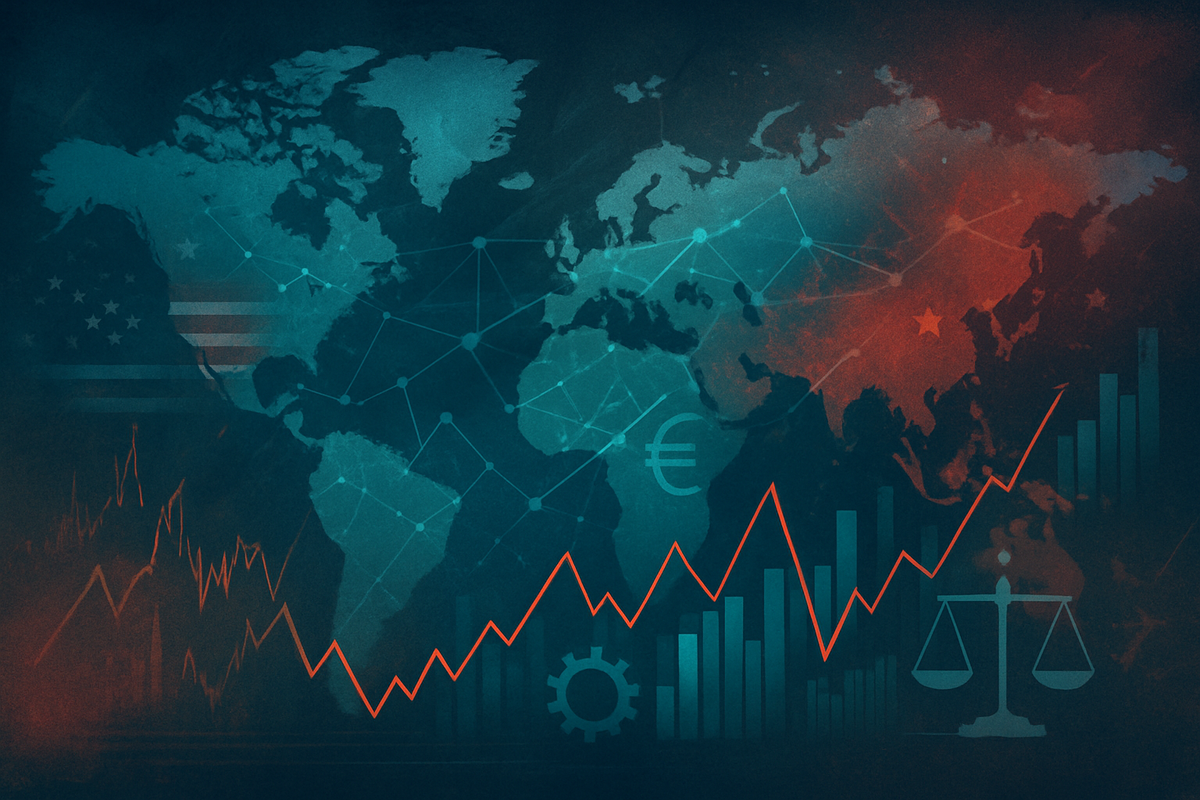
Global financial markets are currently navigating a turbulent landscape, marked by a palpable lack of clear direction as of October 2025. This uncertainty is particularly evident in the mixed performances observed across major Asian and European bourses, signaling a cautious investor sentiment fueled by an intricate web of geopolitical tensions and persistent economic pressures. Far from a unified global rally or retreat, markets are exhibiting a fragmented response, reflecting deep-seated concerns over trade stability, inflationary trajectories, and the efficacy of central bank policies in an increasingly complex world.
The immediate implication of this mixed performance is a heightened sense of volatility and a challenging environment for investors seeking clear trends. While some sectors or regions might experience fleeting gains, the overarching sentiment suggests a market bracing for potential shocks. This equilibrium of caution and opportunistic trading underscores a period where fundamental shifts in global power dynamics and economic structures are exerting a profound influence on daily trading, making long-term strategic planning more arduous for corporations and investors alike.
A Tapestry of Disparate Market Movements and Lingering Global Challenges
October 2025 has been characterized by a noticeable divergence in market performance across continents. In Asia, indices like Japan's Nikkei 225 (TYO: N225) saw fluctuations, sometimes dipping and at other times surging, often tracking Wall Street's cues but remaining susceptible to regional anxieties. The Shanghai Composite (SSE: 000001) and Hang Seng Index (HKG: HSI) in China and Hong Kong, respectively, registered marginal gains on some days, yet continued to battle vulnerabilities stemming from Beijing's efforts to stimulate a real estate sector still reeling from developer defaults and falling housing prices. South Korean shares, however, found some impetus from a new trade deal with the United States, illustrating the localized impacts of policy developments.
Europe mirrored this fragmented picture, with the STOXX 600 (EURONEXT: STOXX600) and London's FTSE 100 (LSE: UKX) often showing gains, partly driven by strong corporate earnings. Yet, economic bellwethers like Germany's DAX (XTRA: GDAXI) and France's CAC 40 (EURONEXT: PX1) frequently lost ground, reflecting deeper concerns within the Euro Area. The Euro Stoxx 50 (EURONEXT: SX5E) also saw a slight dip after reaching an earlier monthly high. This cautious stance across the continent was largely attributed to eagerly anticipated economic growth data, ongoing corporate earnings season, and the looming European Central Bank (ECB) rate decision.
The backdrop to these market movements is a series of entrenched geopolitical and economic uncertainties. U.S.-China trade tensions, despite intermittent reports of progress on specific tariff reductions or commodity purchases, remained a significant overhang, threatening global supply chains and output. The ongoing conflicts in Ukraine and between Israel and Hamas continued to disrupt cross-border trade and investment flows, contributing to elevated commodity prices and increased sovereign risk premiums worldwide. Domestically, a partial U.S. government shutdown in October 2025 underscored growing institutional fragility, complicating business planning and investment decisions. Even traditional safe havens were not immune, as gold experienced an unprecedented 5% single-day collapse on October 21, challenging its historical role amidst profit-taking after a significant rally.
Economically, the primary drivers of uncertainty revolved around central bank monetary policy. The U.S. Federal Reserve delivered its second consecutive rate cut in October, but Chair Jerome Powell's cautious remarks tempered expectations for further cuts, leading to increased U.S. Treasury yields and a strengthening dollar. The ECB was widely expected to hold rates, with its forward guidance on inflation being closely watched. Persistent inflationary pressures, particularly in the U.S. and UK, coupled with widening fiscal deficits and elevated global debt levels, signaled increasing fiscal stress, especially for lower-income nations. Concerns over the sustainability of AI investment, despite driving some equity market gains, also began to surface, with questions arising about the timing and magnitude of returns on these significant capital outlays.
Corporate Fortunes Diverge Amidst Global Crosscurrents
The intricate web of geopolitical and economic uncertainties is creating a stark divergence in fortunes across the corporate landscape. Companies demonstrating agility, strategic resilience, and alignment with new global priorities are poised to navigate these turbulent waters, while those heavily reliant on stable global supply chains or vulnerable economic conditions face significant headwinds.
Defense and aerospace companies are among the clear beneficiaries of heightened global tensions. With ongoing conflicts in Ukraine and the Middle East, governments worldwide are increasing defense spending, leading to robust demand for military equipment, cybersecurity solutions, and related services. Industry giants like Lockheed Martin (NYSE: LMT) and Raytheon Technologies (NYSE: RTX) are seeing stable order backlogs and long-term government contracts, underpinning their stock performance. Similarly, the escalating threat of cyber warfare and digital espionage is fueling demand for cybersecurity and digital resilience providers. Companies such as Palo Alto Networks (NASDAQ: PANW) and CrowdStrike (NASDAQ: CRWD) are experiencing sustained growth as essential service providers, regardless of broader economic slowdowns, as businesses and governments fortify their digital infrastructures.
The imperative for supply chain resilience is also creating opportunities. As companies seek to diversify sourcing and mitigate geopolitical and climate risks, providers of advanced logistics and supply chain management software are gaining traction. While specific public examples are harder to pinpoint in this niche, companies like Manhattan Associates (NASDAQ: MANH), which offer supply chain solutions, stand to benefit from increased corporate investment in robust and transparent logistics. Furthermore, the dual drivers of climate change mitigation and energy security are accelerating investment in renewable energy and resilient infrastructure. Firms like NextEra Energy (NYSE: NEE) in renewable energy generation and First Solar (NASDAQ: FSLR) in solar panel manufacturing are positioned for growth, supported by long-term secular trends and substantial public and private sector spending. The insatiable demand for AI infrastructure also benefits data center providers such as Digital Realty Trust (NYSE: DLR), which are critical for powering AI's energy-intensive operations. Even critical minerals companies, especially those diversifying non-Chinese sourcing, like MP Materials (NYSE: MP), could see strategic investments, though their stock can be volatile. Lastly, AI innovators like NVIDIA (NASDAQ: NVDA) and cloud infrastructure providers like Microsoft (NASDAQ: MSFT) continue to thrive as businesses report positive ROI from AI, driving demand for chips, software platforms, and specialized hardware.
Conversely, several sectors are facing significant headwinds. Global manufacturing companies with complex, internationally integrated supply chains are particularly vulnerable to tariffs, trade policy shifts, and geopolitical disruptions. These factors are stalling investment, increasing operating costs, and forcing a costly rethink of globalization strategies. Energy-intensive industries, such as heavy manufacturing and chemicals, exemplified by companies like Dow Inc. (NYSE: DOW), are grappling with volatile and elevated energy costs stemming from ongoing geopolitical conflicts, which squeeze profit margins. The severe downturn in China's real estate sector continues to impact global commodity markets, negatively affecting mining companies and construction material suppliers reliant on Chinese demand. Financial institutions with significant exposure to Chinese property developers, though not explicitly named, face increased risks of non-performing loans. Lastly, technology companies caught in the crosshairs of US-China tech rivalry, such as Micron Technology (NASDAQ: MU) or Applied Materials (NASDAQ: AMAT), face ongoing risks of disrupted supply chains, restricted market access, and increased R&D costs to diversify technology sourcing, leading to volatile stock performance.
Wider Significance: Reshaping Global Commerce and Governance
The pervasive geopolitical and economic uncertainties gripping global markets in October 2025 are not merely transient disturbances; they are accelerating fundamental shifts in global commerce and governance, signaling a strategic pivot away from the unbridled globalization of previous decades. This era is characterized not by a full retreat into deglobalization, but rather a more pragmatic and selective approach, prioritizing resilience and security over pure efficiency.
This environment is significantly reorganizing global structures, driving profound trends like reshoring, nearshoring, and friendshoring. While "deglobalization" implies a reduction in international interdependence, the current reality leans towards a "smarter evolution" where companies are bringing manufacturing back home (reshoring), relocating production to nearby countries (nearshoring), or sourcing from geopolitically allied nations (friendshoring). This strategic shift, driven by the vulnerabilities exposed during the COVID-19 pandemic, ongoing conflicts, and climate disruptions, aims to mitigate risks associated with distant and complex supply chains. Over 70% of global manufacturing firms have already begun diversifying their supplier bases and moving operations closer to home, prioritizing risk mitigation and continuity. However, this comes with a potential trade-off: the OECD warns that extensive reshoring could reduce global GDP by up to 5% and decrease international trade by over 18%, highlighting the delicate balance between security and economic efficiency.
The ripple effects of these trends are far-reaching, impacting competitors and partners across industries. While friendshoring and reshoring enhance supply chain security, they can lead to increased production costs and reduced efficiency, potentially affecting the competitiveness of companies that fully embrace these shifts without careful planning. Supply chain disruptions, exacerbated by tariffs and trade policy shifts, create cascading effects, forcing companies to build more diverse supplier portfolios and re-evaluate their international trade relationships. Emerging markets, which have historically benefited from global trade integration, are particularly vulnerable to these shifts and reduced foreign investment. Moreover, technological rivalries, particularly between the US and China, are intensifying, leading to export controls on critical technologies like semiconductors and AI, further reshaping supply chain dependencies and fostering a more fragmented global tech landscape.
In response, governments are increasingly intervening in markets and adjusting trade policies, marking a new economic era where economic security often trumps economic efficiency. The reintroduction of broad tariffs, such as the universal 10% tariff on all imports by the US, with significantly higher tariffs against certain nations like China, represents a major policy shift aimed at bolstering domestic industries and addressing trade imbalances. Countries like the US, India, Japan, and EU members are also offering tax breaks, subsidies, and faster approvals to incentivize reshoring in essential industries. This focus on economic nationalism and decoupling from certain countries, particularly China, underscores the protection of critical industries and increased scrutiny of foreign dependencies. The World Trade Organization (WTO) also faces challenges, with its appeals body paralyzed, pushing nations towards alternative bilateral and multilateral agreements.
Historically, the current environment draws parallels to periods of intense economic nationalism and trade conflicts. The Smoot-Hawley Tariff Act of 1930 serves as a stark cautionary tale, where raised US tariffs led to retaliatory measures, exacerbated the Great Depression, and is even cited as a contributing factor to global instability before World War II. Lessons from such trade wars consistently show disruptions to global supply chains, increased prices for consumers, and prolonged economic stagnation. The current emphasis on securing critical supply chains and reducing reliance on specific nations echoes sentiments from earlier centuries when nations sought to protect nascent industries. Understanding these historical precedents is crucial, as they underscore the potential for unintended consequences and the critical need for coordinated international cooperation to navigate these turbulent waters effectively.
What Comes Next: Navigating a New Economic Frontier
As global markets grapple with unprecedented uncertainties in October 2025, the path forward demands a blend of cautious optimism and strategic agility from both businesses and investors. The immediate horizon suggests continued volatility, while the long-term outlook points to a fundamental reshaping of the global economic order.
In the short-term (late 2025 - early 2026), markets are likely to remain highly reactive to central bank decisions, particularly those from the U.S. Federal Reserve, which is expected to deliver further rate cuts, potentially creating a favorable environment for US equities. Economic data releases, corporate earnings, and any new developments in ongoing geopolitical conflicts will continue to drive daily sentiment. A recent, albeit "guarded," U.S.-China trade truce offers a temporary sense of relief, potentially sustaining a rally and unfreezing some investment decisions, but it is widely viewed as a tactical pause within persistent underlying tensions. The AI boom is expected to maintain its momentum, driving enthusiasm in technology stocks, though concerns about high valuations and potential market saturation will persist.
Looking at the long-term (1-5+ years), a significant shift in global economic power is underway. Emerging markets are poised to reshape the global economic fabric, with their equities projected to hold 35% of the world market value by 2030. Robust economic growth in these regions, averaging over 4% in 2025, is driven by demographic advantages, rapid technological adoption, and structural reforms. India is emerging as a leading force in Asia, potentially surpassing China in regional influence, while Africa is forecast to have the world's largest working-age population by 2030. Global megatrends, including rapid decarbonization, significant demographic shifts, continued urbanization, the energy transition, hyper-connectivity, and the rise of Industry 5.0 driven by AI and automation, will profoundly shape the world towards 2030, with AI and robotics alone potentially boosting global GDP by up to $15.7 trillion. However, this also ushers in a new, more mercantilist era where trade disruption and more volatile prices become the norm as globalization faces structural headwinds.
For businesses, strategic pivots are essential. Building resilience through diversified suppliers and markets, investing in AI-powered supply chain visibility, and engaging in robust scenario planning are crucial to mitigate shocks from currency volatility and disruptions. Embracing AI and automation is no longer an option but a necessity, transforming operations through predictive analytics, generative AI, and intelligent automation. A strong focus on customer-centric innovation, localization, and regionalization of value chains will also be key to adapting to shifting consumer expectations and trade policies. Businesses operating in or with China, in particular, will need to adapt to its upcoming 15th Five-Year Plan (2026-2030), which prioritizes industrial modernization, innovation for real-world value, economic security, and domestic demand.
Investors must adopt a flexible and vigilant approach. Meticulous risk management and diversification across geographies and asset classes are paramount given elevated financial vulnerabilities and geopolitical tensions. Active management, viewing short-term corrections as entry points, will be crucial. Asset allocation adjustments, favoring US small caps, high-growth cyclicals like software, and high-rated corporate bonds, are advisable. Alternative investments, especially in infrastructure (benefiting from energy transition and digitalization) and early-stage AI-driven venture capital, present significant long-term opportunities. Closely monitoring the monetary policy developments of major central banks, particularly the U.S. Federal Reserve and the Bank of Japan, will remain critical due to their impact on bond yields and global capital flows.
Emerging markets present compelling opportunities but also inherent challenges. While offering robust growth potential driven by technology and demographic dividends, they are characterized by inherent volatility and susceptibility to geopolitical risks. External headwinds, such as "higher-for-longer" interest rates, a strong US dollar, tighter financing conditions, and an uncertain global trade environment, pose significant challenges, particularly for economies with weaker policy frameworks and high debt burdens.
Potential scenarios range from a base case of subdued growth with persistent uncertainty, where the global economy experiences a moderate slowdown and continued volatility, to a downside scenario marked by increased fragmentation, intensified trade wars, or a sharp financial market correction. An upside scenario, though less likely given current trends, could see an innovation-led recovery fueled by AI and renewed multilateral cooperation, fostering higher productivity and more robust global economic growth.
Comprehensive Wrap-up: Adapting to a Fragmented Future
The global financial markets in October 2025 are undeniably at a crossroads, defined by a complex interplay of geopolitical tensions and economic uncertainties that preclude any clear global market direction. The mixed performance across Asia and Europe is a clear indicator of this fragmentation, where localized successes are overshadowed by overarching concerns about trade stability, inflation, and the efficacy of monetary policy. The era of seamless globalization is yielding to a more nuanced, "selective globalization," characterized by trends like reshoring and friendshoring, as nations and corporations prioritize security and resilience over pure cost efficiency.
Moving forward, the market will likely remain highly sensitive to central bank guidance, geopolitical flashpoints, and corporate earnings. While the AI revolution continues to present significant growth opportunities, particularly in technology and infrastructure, it also introduces questions about valuation sustainability. The long-term trajectory points towards a multipolar economic world, with emerging markets playing an increasingly dominant role, but not without navigating their own unique set of volatilities and challenges.
Investors should watch for continued shifts in trade policies, the evolution of central bank interest rate strategies, and the real-world impacts of ongoing conflicts on commodity prices and supply chains. Companies will need to demonstrate exceptional adaptability, focusing on supply chain diversification, technological innovation (especially AI), and regionalized strategies to thrive in this new, more mercantilist economic environment. The ability to anticipate and respond to rapid shifts in global dynamics will be the ultimate differentiator.
This content is intended for informational purposes only and is not financial advice






